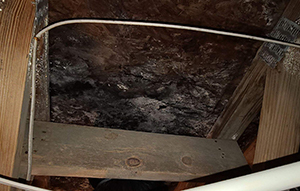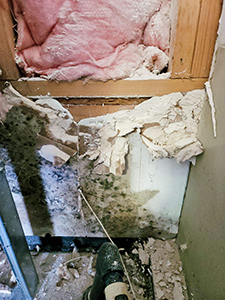What is Mold?
Mold is a type of fungus. It comes in a variety of types and colors, including white, black, green, purple and orange. Mold spreads via airborne spores and love dark, damp places. Mold can grow on just about any surface, including walls, carpet, ceilings, furniture, clothes, etc. Damp areas such as your kitchen, laundry room, crawl space, closets and bathrooms are good places to find mold.
Mold can cause damage to your home (wet rot and dry rot) as well as create an unhealthy environment for you to live in. Mold has been known to cause respiratory illness in the young and old alike, in  severe cases even causing death. Mold can grow very quickly, often times as quickly as 24-hours if conditions are right.
severe cases even causing death. Mold can grow very quickly, often times as quickly as 24-hours if conditions are right.
What are some ways to prevent mold?
Mold loves dampness, so reducing the humidity in your home can help. The suggested range for the humidity in your home is 30% – 50%, though we suggest you keep it closer to 40%. Make sure that you quickly clean up any major water spills (toilet or bathtub overflow).
Properly maintaining your roof can go a long way in preventing mold caused by slow leaks. If you wait too long to clean up the, the water can easily find its way into the baseboards or framing of your home. Once there, it takes some time, and sometimes dehumidifiers, to dry it out. Make sure you are cleaning your drip pans on any of your air conditioners as the drainage tube has a very narrow diameter and even small debris can stop it up (The drip pans are often located in the attic of your home).
If you have any leaks under your counters, under your water features or under your house, see that they are repaired quickly. A slow drip under a counter is a perfect breeding ground for mold. If you can, keep doors open inside your house to allow air to circulate through. Use dehumidifiers if you live in very hot and damp climates. If you live in cool climates, keep your house warm to prevent condensation. And above all, make sure your crawlspace or basements is properly ventilated and the vapor barriers are put down correctly.
What are some signs I could have mold in my house?
One of the most obvious is dark spots on your walls or ceilings. Most people are familiar with mold on their food. On the surfaces of your home you can see something very similar. Mold on the surface is usually pretty easy to spot. Mold growing in the walls, in the crawl space or even behind wall paper can be much harder to find. Any signs of water damage should be investigated (cracked or peeling paint, bulges in the walls or ceiling or water marks).
Any drywall surface that gets wet should be replaced to ensure that mold does not grow on it. The surface of untreated drywall (i.e. that side not painted) is full of cellulose, making it a great place for mold to grow and thrive, especially in a damp, dark space between the walls.
For some mold problems, smell can be another good indicator. Mold has a mild but pungent odor in most cases. When the mold growth is very heavy, the smell can be quite sharp and even nauseating.
Can mold cause me health problems?
 Yes, mold can cause many unexplained health problems in your home. Mold in air conditioner ducts or anywhere else where the spores are constantly being breathed in can cause a variety of health issues, including (but not limited to) mold induced asthma, chronic sinus issues, allergy like symptoms (watery eyes and sore throats), rash and skin irritation, nosebleeds, nausea, random aches and pains, headaches and fatigue.
Yes, mold can cause many unexplained health problems in your home. Mold in air conditioner ducts or anywhere else where the spores are constantly being breathed in can cause a variety of health issues, including (but not limited to) mold induced asthma, chronic sinus issues, allergy like symptoms (watery eyes and sore throats), rash and skin irritation, nosebleeds, nausea, random aches and pains, headaches and fatigue.
Since mold symptoms can be very similar to other illnesses, it is always good to have the house inspected for a possible hidden mold infestation or talk to a doctor about your symptoms.
If I find mold, what should I do?
It is always advisable to have a licensed and trained professional clean any mold that you may have around the house. Professionals have specialized tools to properly identify the type of mold, and the expertise to mitigate the mold properly.
If you choose to clean the mold yourself, it is important to ensure you are you working the correct Personal Protective Equipment (PPE) so that you do not get sick.
Standard masks, even N95 masks, are not sufficient to keep out mold spores. If you can’t get a professional to your home quickly, close off all of the rooms that contain mold. You’ll need to use plastic sheets and painters tape to fully close off the air access from the affected areas. If possible, either turn the heat up in the affected room (without a condenser this isn’t terribly effective so you’ll also need to open the windows periodically to let the moist air out).
Next you’ll want to rent a HEPA air filter and run it in the areas of the home that don’t contain mold. Running the HEPA filter in the mold affected area will only serve to spread the spores further into the home. Home Depot, Lowes and tool rental companies often have this equipment. Killing the mold is only half the work.
Cleaning up the residue and making sure it has not spread to other areas are just as important. Mold spores are nearly microscopic, so a visual test by the untrained eye will not be sufficient to ensure the mold is gone. You’ll want to let a trained professional do this, and you’ll want to conduct mold tests after the clean-up is completed.
One item that is often missed when cleaning up mold is the air-ducts. If mold is in your home, especially if it’s present near the air intakes, your ducts are likely compromised and will need to be cleaned. This is a relatively inexpensive trade to have completed, but goes a long way in ensuring that your home is mold free.
Also, repairing any damage that may have caused the mold in the first place (i.e. slow leak in a pipe under the house or maybe some wet insulation) is just as important. If you do not clean the original problem, it is likely that the mold will just return again.
If you have a question or concern about possible mold in your home, just ask. We can be reached at 919-916-5640 or at [email protected]. We are here to help. It’s possible for mold to find itself a new home in any given area of your house. We’ve had to replace insulation infested with mold, replace siding that allowed water to get underneath and cause mold, and tons of similar issues. Don’t forget to follow us on social media for our latest deals and specials & events!
